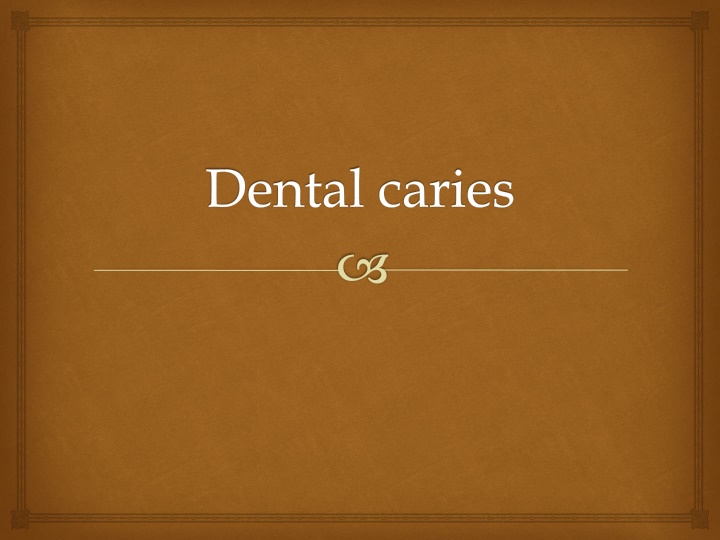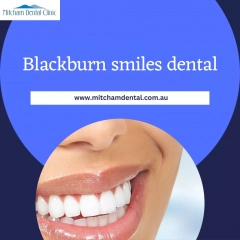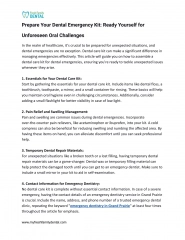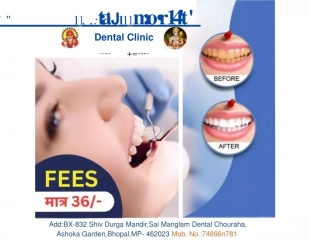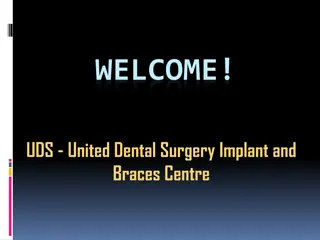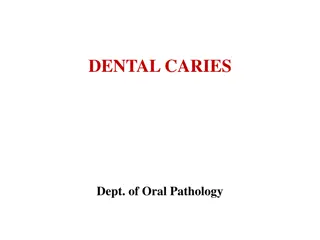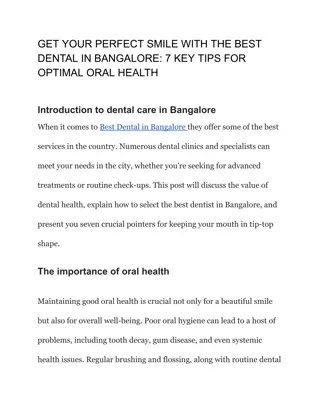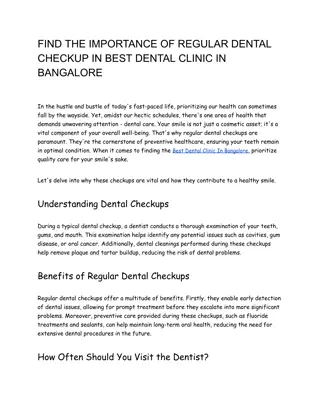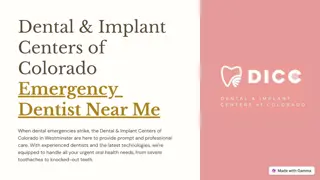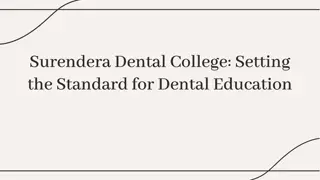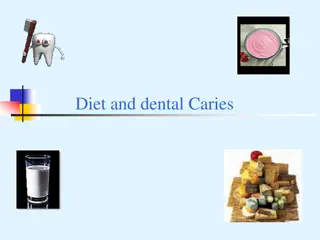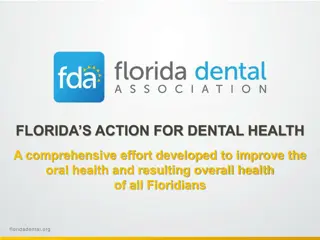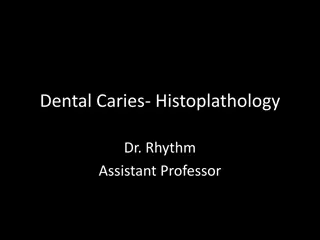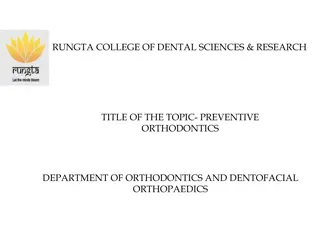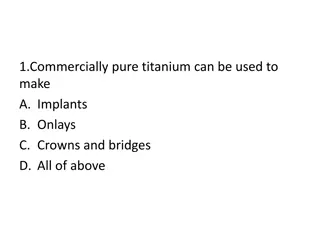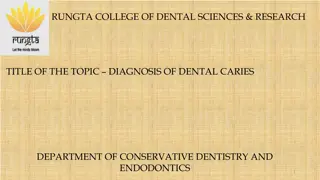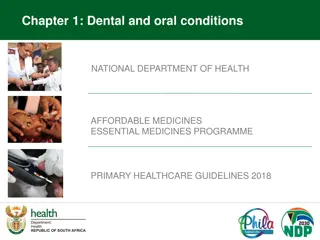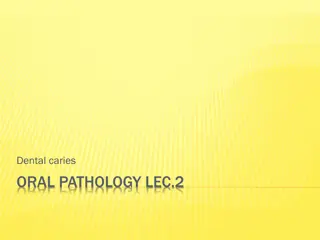Dental Caries Etiology and Classification
Dental caries is a microbiological disease affecting the hard structure of teeth, leading to demineralization and destruction. Learn about etiology, local factors, clinical classification, and zones of caries in enamel and dentin.
Download Presentation

Please find below an Image/Link to download the presentation.
The content on the website is provided AS IS for your information and personal use only. It may not be sold, licensed, or shared on other websites without obtaining consent from the author.If you encounter any issues during the download, it is possible that the publisher has removed the file from their server.
You are allowed to download the files provided on this website for personal or commercial use, subject to the condition that they are used lawfully. All files are the property of their respective owners.
The content on the website is provided AS IS for your information and personal use only. It may not be sold, licensed, or shared on other websites without obtaining consent from the author.
E N D
Presentation Transcript
What is etiology of dental caries? dental caries is defined as a microbiological disease of the hard structure of teeth, exposed in oral cavity that results in localized demineralization of the inorganic portion and destruction of the organic substances of the tooth, beginning on the external surface. Etiology
Local factors affecting the incidence of caries: Microorganisms: microorganisms present, on the tooth surface like Streptococcus mutants and Lactobacillus cause dental plaque. Tooth: a. morphological variation. B. composition. C. position. Environmental factors: a. saliva: 1. Composition. 2. Quantity. 3. PH viscosity. 4. Antibacterial factors like enzymes. b. diet: carbohydrate content-Presence of refined cariogenic carbohydrate particles on the tooth surface. a. vitamin content. b. fluoride content. time period.
Give clinical classification of dental caries? 1. 2. 3. 4. Pits and fissures caries Smooth enamel surface caries Root surface caries Cervical caries
The rapidity of the caries progress, it is classified as follows: a. b. Rampant caries c. Chronic dental caries d. Arrested caries Acute dental caries
Whether caries attacks previously intact surface or margin of restoration, it is classified as follows: 1. Primary caries 2. Secondary or recurrent caries
What is caries of enamel? Smooth surface caries Pit and fissure caries Zone in caries lesions: 1. Zone 1: translucent zone 2. Zone 2: dark zone 3. Zone 3: body of lesion 4. Zone 4: surface zone
What is caries of dentin? Changes in early dentinal caries Changes in advanced dentinal caries Zones of dentinal caries: Zone 1: normal dentin Zone 2: sub transparent dentin Zone 3: zone of dentinal sclerosis (transparent dentin) Zone 4: turbid dentin Zone 5: decomposed dentin
Difference between infected and affected dentine Infected dentine: It is a superficial layer. Demineralized dentine. Can't be remineralized with irregularly scattered crystals. Collagen fibers are broken down; appear as only indistinct cross bands. It can be stained
Affected dentine It is a deeper layer. Intermediate demineralized dentine. Can be remineralized. It is sensitive. In this intertubular layer is only partly demineralized. It cannot be stained with any solution.
What are different methods of caries diagnosis? 1. 2. 3. 4. Detection of carious enamel by dyes 5. Endoscope technique 6. Tactile method 7. Radiographic methods: I. Intraoral periapical radiographs. II. Bitewing radiographs III. Xeroradiography IV. Digital imaging. (Direct digital imaging) Visual inspection methods Special illumination techniques Fiber optic Trans illumination (FOTI)
What are different ways for caries prevention? Chemical method: Fluoride: fluoride alters the tooth surface or/and tooth structure to increase resistance to demineralization and prevent dental caries. Fluorides are used in the following forms: a- Fluoridation of water supplies. b- Topical application of fluoride: i. Sodium fluoride (NaF) ii. Stannous fluoride (SnF2) iii. Acidulated fluoride-phosphate. iv. Prophylactic paste. v. Fluoride dentifrices. vi. Fluoride mouthwashes or rinses. Chlorhexidine. Caries vaccine.
Dietary method Mechanical methods: Tooth brushing. Dental floss. Mouth rinsing. Pit and fissure sealants.
Indirect pulp capping: Indications: Deep carious lesion near the pulp tissue but not involving it. No mobility of tooth. No history of spontaneous toothache. No tenderness to percussion. No radiographic evidence of pulp pathology. No root resorption or radicular disease should be present radiographically.
Contraindications: Presence of pulp exposure. Radiographic evidence of pulp pathology. History of spontaneous toothache. Tooth sensitive to percussion. Mobility present. Root resorption or radicular disease is present radiography. Materials used: Zinc oxide eugenol. Calcium hydroxide.
Direct pulp capping: Indications: Small mechanical exposure of pulp during: Cavity preparation. Traumatic injury. No or minimal bleeding at the exposure site. Contraindications: Wide pulp exposure. Radiographic evidence of pulp pathology. History of spontaneous pain. Presence of bleeding at exposure site.
Materials used for pulp protection The materials used for pulp protection: Cavity varnish. Cavity liners. Calcium hydroxide and mineral trioxide aggregate (MTA). Zinc oxide-Eugenol. Zinc phosphate cement. Polycarboxylate cement. Glass ionomer cement.
